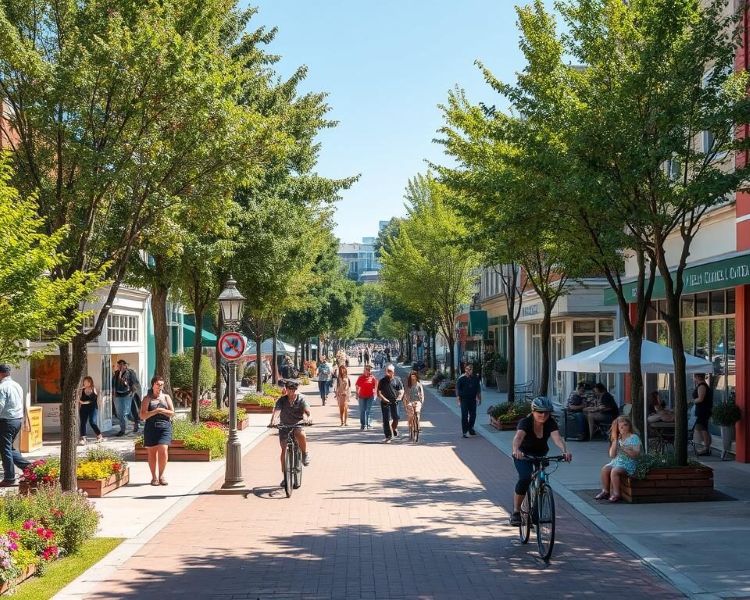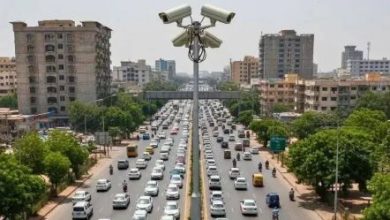Pakistan’s Women: Designing Safe Urbanism
How Urban Design and Walkability Shape Women’s Security in Pakistan

In Pakistan in general, and especially in Sindh, the decline of pedestrian life has quietly intensified gender inequality.
- Rebuilding walkability through women-centered design, improved transit links, and community engagement can transform not just mobility but the entire social contract.
Mohammad Ehsan Leghari and Umama Leghari
Cities across the world are slowly discovering a truth women have long known: the ability to walk safely determines the ability to live freely. Walkability something that leads to safe, comfortable access to everyday destinations, sounds like an urban planning term, but for women it is the boundary between mobility and confinement. When sidewalks vanish, lights fail, or traffic dominates, women’s worlds shrink.
In Pakistan, where 70–80% of women face harassment in public transport or on the street, walkability is not a luxury but a gender justice issue [1][2]. And because women walk more than men, rely more on public transit, and often travel with children or elders, they face the brunt of unsafe urban design.
Walkability affects everything: access to school, access to jobs, and access to health care. It shapes how women navigate fear; and how much of the city they are allowed to occupy.
Why Walkability Matters for Women’s Safety
Walkability is built on simple principles: continuous sidewalks, safe crossings, mixed land uses, and well-lit streets. But as Jane Jacobs famously argued, a street is safe when there are “eyes on the street”: passersby, active shop fronts, and windows facing public space [3].
This basic idea forms the heart of Crime Prevention Through Environmental Design (CPTED), which shows that visibility, activity, and openness deter harassment and violence [4]. Yet evidence shows that women experience streetscapes differently from men. Studies from multiple countries confirm that women consistently report higher fear and avoid isolated paths and poor lighting even when crime rates are low [5].
Furthermore, research emphasizes that perception of safety is as important as the physical environment. Familiarity, crowd presence, and predictable routes matter more to women’s choices than sheer distance or travel time [6]. A wide, empty road can feel more dangerous than a narrow but active bazaar.
 Walkability, Mobility, and Women’s Economic Participation
Walkability, Mobility, and Women’s Economic Participation
When walking feels unsafe, women’s opportunities immediately narrow. In cities where public transit is unreliable and pavements are broken, the journey to work can be humiliating or dangerous.
Pakistan is no exception:
- 78% of women in Karachi report harassment during travel [7]
- 70% of Pakistani women using public transport experience unwanted advances [2]
- 40% of women avoid leaving home after dark [2]
- Pakistan’s female labor force participation (around 21% nationally, and 11% in urban Sindh) is one of the lowest globally [8]
The link is direct. An Urban Institute study noted that fear of harassment “restricts women’s mobility and hampers access to jobs” [1]. A Lahore experiment found that when women were offered safe commuting options, job applications tripled [9].
Mobility is therefore not only a transport issue—it is a poverty issue.
Global Lessons: How Other Cities Made Walking Safer
Bogotá, Colombia
Bogotá’s gender-sensitive audits, conducted through the SafetiPin app, mapped unsafe spots using crowdsourced data. The city improved lighting, added CCTV, widened sidewalks, and built 500+ km of bike lanes [10]. Women reported increased confidence in using public spaces at night.
Recife, Brazil
A Recife study found that women consider walking the least safe travel mode, especially in deserted or poorly lit streets [11]. Hotspots like alleys and underpasses were identified as risk zones due to lack of surveillance.
Vienna, Austria
Vienna’s “Frauen-Werk-Stadt” incorporated CPTED and gender-sensitive design: wide pavements, clear sightlines, and windows overlooking play areas. Women’s reported fear declined in pilot districts [12].
India
Delhi’s Safe City Project built better-lit bus stops, increased women’s patrols, and introduced panic buttons in transit—demonstrating how mixed interventions (design + enforcement) improve women’s sense of security [13].
Across regions, a clear pattern emerges: walkability + visibility + activity = safety.
Pakistan’s Urban Crisis: Karachi, Hyderabad, Lahore
Despite rapid urbanization, Pakistan’s cities remain car-centric, chaotic, and deeply unfriendly to pedestrians. Though appreciable effort, investments has resulted implementation of projects in both Karachi and Lahore, and there are marked improvements; but these are not women focused. Hyderabad has also shown some basic advancements. But collectively the gaps in Urban centers are extensive, which require consistent and people (especially women) oriented planning approaches to bring the incremental and impacting changes.
Karachi
Sindh has begun taking meaningful steps toward safer and more walkable cities. The Karachi Neighborhood Improvement Project, implemented by with World Bank support, upgraded footpaths, lighting, crossings, and public spaces in Saddar, Malir, and Korangi; representing one of the province’s first coordinated attempts to humanize street design. Alongside this, gender-focused mobility initiatives such as the Pink Scooty Scheme and the upcoming Pink Taxi Service aim to provide women with safe, independent commuting options. While these efforts are promising, they remain largely project-based, and their transformative potential will depend on evolving them into a long-term, programmatic framework that integrates walkability, women’s safety, and urban mobility into the core of Sindh’s planning and development agenda. Only then can these isolated successes scale into a sustained urban shift that truly empowers women and reshapes public space.
Still in larger scale in Karachi, sidewalks are typically broken, blocked, or nonexistent; traffic is aggressive; and lighting is inconsistent. A 2025 magazine feature described women forced to choose between unsafe motorbike taxis, overcrowded buses, or long walks “none of which feel safe or affordable” [15].
Hyderabad
Narrow lanes, nonexistent footpaths, and unsafe crossings make even short walks hazardous. University of Sindh campuses lack basic crosswalks and lighting, disproportionately affecting female students. With meagre budgets and almost no infrastructure investments for more than a decade in University, urgent action is required, especially for girl students related needs of infrastructure and upkeeps.
Nationwide Patterns
Repeated studies show:
- 75% of women would work if safe transport existed [8]
- 40% alter routes to avoid harassment [1]
- Women perceive public areas as twice as unsafe as men do [6]
Fear produces a “self-imposed curfew,” shrinking women’s access to city life.
Recommendations for Pakistan and province of Sindh
- Build Safe, Continuous Sidewalks
Widen footpaths, remove encroachments, repair broken tiles, and create curb ramps. Mixed-use edges increase Natural Surveillance.
- Prioritize Lighting
Illuminate pedestrian routes, not just roads. Install tamper-resistant LEDs and ensure maintenance.
- Apply CPTED Principles:
Transparent bus shelters, active street fronts, clear sight-lines, avoid tall blank walls and, add seating and vendors.
- Integrate Public Transport with Walking: Safe last-mile routes, women-only feeder vans, well-lit BRT stations, and real-time help features. The good news that women related transport buses have been arranged by government of Sindh especially in Karachi.
- Enforce Anti-Harassment Laws: Train police, deploy women officers, and punish transit harassment.
- Women-Centered Planning: Mandatory gender audits of urban projects; participatory walks; women-led transit design teams.
- Green Infrastructure: Tree-lined sidewalks, shaded routes, and small plazas encourage pedestrian presence—lowering fear and increasing health benefits.
Read: The Impact of Urban Design in minimizing Women’s Fear of Crime
Conclusion
A walkable city is a safer city, and a safer city is a more equal city.
In Pakistan in general, and especially in Sindh, the decline of pedestrian life has quietly intensified gender inequality. Rebuilding walkability through women-centered design, CPTED, improved transit links, and community engagement can transform not just mobility but the entire social contract.
As global evidence shows, when women can walk without fear, society moves forward.
(This article is result of inspired discussions with Ms. Umama Leghari on Urban spaces and mobility of women, on which she conducted a research applying Design Thinking approach for problem solution)
References
- Urban Institute. (2017). Using technology to improve women’s safety in Pakistan’s urban transit systems.
- UN Women. (2018). Women’s Safety Audit in Public Transport in Lahore.
- Jacobs, J. (1961). The Death and Life of Great American Cities.
- Loukaitou-Sideris, A. (2024). Perceptions of Safety for Women in Urban Areas. ACM Digital Library.
- Verma, A., & Jain, A. (2023). The Impact of Urban Design in Minimizing Women’s Fear of Crime. ResearchGate.
- IDRC. (2016). Mobility and access services: gendered violence insights in Pakistan.
- Adeleke, R., Alabede, O., & Mathew, J. (2023). Walkability in Pakistan. Modern Diplomacy.
- World Bank. (2025). Improving Mobility and Jobs for Women: The Case of Karachi.
- Zafar, A., et al. (2025). Women’s mobility challenges in Lahore. Journal of Transport Geography.
- UN Women. (2021). Safe Cities and Safe Public Spaces Global Results Report.
- Silva, L. et al. (2021). Women’s Perception of Safety in Recife.
- City of Vienna. (2013). Gender Mainstreaming in Urban Planning.
- Government of India. (2018–2023). Safe City Mission Reports.
- ADB (Asian Development Bank). (2022). Karachi Urban Mobility Assessment.
- South Asia Magazine. (2025). Women and Urban Mobility in Pakistan.
Read: Guiding Green Building Practices
_________________________
 Mohammad Ehsan Leghari is Member (Sindh), Indus River System Authority, and former Managing Director, SIDA.
Mohammad Ehsan Leghari is Member (Sindh), Indus River System Authority, and former Managing Director, SIDA.




